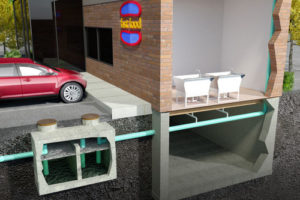Your septic system breaks down waste—not grease. Nowadays, oils and fats easily find their way into septic tanks and sewage systems, clogging pipes and drainfields. Luckily, grease traps can stop this process in its tracks. First, let’s look into why grease hurts waste disposal systems and how grease traps can help.
Why is Grease Bad for Septic Tanks?
After traveling from your home to your septic tank, all your waste divides into three layers in your septic tank:
- Bottom Layer: the “sludge,” or the unbroken down sewage waste
- Middle Layer: wastewater and broken down solids from the sludge layer
- Top Layer: the “scum” layer, things like grease and fats that are lighter than water
With the exit pipe located in the middle layer, septic systems push wastewater and broken down solids through the exit valve into the drainfield. When the scum layer becomes too thick, it shoves the middle layer down. Eventually, your septic tank starts releasing grease and oil into the drainfield over treated wastewater, clogging the pipes and field and putting a halt to your septic systems’ ability to process waste.
And it’s not only septic tanks. Grease wreaks havoc on all waste disposal systems. It clogs the pipes in sewer systems and causes blockages in city treatments plants.
But, what can you do?
How Do Grease Traps Work?
 Grease Traps are named appropriately—they trap grease before it makes it into the pipes leading to the sewer system or the septic tank.
Grease Traps are named appropriately—they trap grease before it makes it into the pipes leading to the sewer system or the septic tank.
Using two baffle chambers, they naturally divide waste into three layers. Initial separation occurs in the first chamber with a pipe leading from the middle wastewater layer into the second baffle. An exit pipe in the second baffle allows the waste water (minus the grease) to leave to the sewer or enter the septic tank.
However, it’s important to note that grease traps are not infallable—they will still let small amounts of grease into the system. This amount increases as the traps fills up. There are no bacteria or natural processes breaking down solids in the trap. Eventually, it will fill up and stop working.
Do Residential Septic Systems Need a Grease Trap?
While commercial systems require a grease trap, especially restaurant and kitchen businesses, they are not necessary for residential septic systems.
The most important tip for residential homes is to follow proper “Do Not Flush” rules. Avoid putting grease into your system by using the trash over the garbage disposal and wiping plates and pans before putting them in the dishwasher. Installing effluent filters also helps reduce the amount of oils and fats entering your drainfield.
Grease Trap Service
Once full, your grease trap becomes foul-smelling—and potentially hazardous with some safety problems associated with poorly maintained traps.
Enter Advanced Septic Services. Our trained technicians don’t just scrape off the top layer, leaving hardened deposits like some operations. We clean the entire trap including unbroken down waste, scum and hardened grease. After grease trap service, your trap is free of accumulations or unpleasant odors. Additionally, you won’t have to pump it as often—we got it all.
Grease traps save your commercial waste disposal system—sewer or septic. All of those unprocessable oils and fats do not reach or clog your pipes or drainfield. But, like the rest of your system, a grease trap needs maintenance. Call Advanced Septic Services at 352.242.6100 today to schedule a grease trap installation or service.

